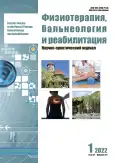The effectiveness of hypo-hyperoxic training in the medical rehabilitation of patients who have undergone COVID-19
- Authors: Volovets S.A.1, Tsyganova T.N.2, Badalov N.G.1,3
-
Affiliations:
- L.I. Shvetsova Scientific and Practical Center for Medical and Social Rehabilitation
- Cellgim-Rus Ltd.
- I.M. Sechenov First Moscow State Medical University (Sechenov University)
- Issue: Vol 21, No 1 (2022)
- Pages: 35-46
- Section: Original studies
- URL: https://journals.rcsi.science/1681-3456/article/view/108605
- DOI: https://doi.org/10.17816/rjpbr109501
- ID: 108605
Cite item
Abstract
BACKGROUND: Interval hypo-hyperoxic training is a new promising technology in medical rehabilitation, including the rehabilitation of patients with post-COVID syndrome. However, the mechanisms of therapeutic action of interval hypo-hyperoxic training in the recovery period after suffering COVID-19 have not been fully studied. The effectiveness of interval hypo-hyperoxic training largely depends on the method of interval hypo-hyperoxic training.
AIM: to develop modes and study the effectiveness of the use of interval hypoxic training in patients with post-COVID syndrome.
MATERIALS AND METHODS: The performed open randomized comparative study involved patients with a diagnosis of post-COVID syndrome ― "Condition after COVID-19" according to the ICD (code U09.9). Patients of the main group, against the background of a course of traditional rehabilitation treatment, received interval hypo-hyperoxic therapy from the OXYTERRA device. In the comparison group, patients received only a traditional course of rehabilitation treatment. The study was conducted for 4 months. To assess the effectiveness of interval hypo-hyperoxic training before and after the course of rehabilitation, we studied the dynamics of the parameters of the circulatory system and the function of external respiration.
RESULTS: 50 patients (19 women, 31 men, mean age 61.7±7.7 years) were randomly divided into the main group (n=30) and the comparison group (n=20). All patients completed a full course of rehabilitation. It was established that the course of training with interval hypo-hyperoxic training contributed to an increase in the oxygen capacity of the blood, an increase in the oxygen content in arterial blood, a decrease in heart rate, normalization of the level of systolic and diastolic pressure, restoration of stroke and minute blood volume parameters in patients of the main group. Interval hypo-hyperoxic training caused an improvement in the functional state of the bronchopulmonary system (p <0.049). There was an improvement in the activity of the central ergotropic and humoral-metabolic mechanisms of heart rhythm regulation, correction of the activity of the sympathetic link of regulation and the modulating effect of the parasympathetic division on the heart rhythm, normalization of the vagosympathetic balance coefficient.
CONCLUSION: The use of interval hypo-hyperoxic training in the recovery period in patients with post-COVID syndrome according to the developed method caused a stable improvement in the clinical condition, which lasted from 3 to 6 months after the completion of complex rehabilitation.
Full Text
##article.viewOnOriginalSite##About the authors
Svetlana A. Volovets
L.I. Shvetsova Scientific and Practical Center for Medical and Social Rehabilitation
Email: volovets@mail.ru
ORCID iD: 0000-0001-5560-6235
SPIN-code: 2698-1409
MD, Dr. Sci. (Med.), Professor
Russian Federation, MoscowTatyana N. Tsyganova
Cellgim-Rus Ltd.
Email: tanya8279@yandex.ru
ORCID iD: 0000-0001-7351-0579
SPIN-code: 7772-1759
MD, Dr. Sci. (Med.), Professor
Russian Federation, MoscowNazim G. Badalov
L.I. Shvetsova Scientific and Practical Center for Medical and Social Rehabilitation; I.M. Sechenov First Moscow State Medical University (Sechenov University)
Author for correspondence.
Email: badalov@cmir.info
ORCID iD: 0000-0002-1407-3038
SPIN-code: 2264-4351
MD, Dr. Sci. (Med.), Professor
Russian Federation, Moscow, MoscowReferences
- Xi L, Serebrovskaya T. Intermittent hypoxia and human diseases. Springer, UK; 2012. 316 p.
- Xi L, Serebrovskaya T. Intermittent hypoxia: from molecular mechanisms to clinical applications. Nova Science Publishers, Inc.; 2009. 615 p.
- Tsyganova TN. Development of the science of hypoxia. Physiotherapist. 2015;(5):76–84. (In Russ).
- Kolchinskaya AZ, Tsyganova TN, Ostapenko LA. Interval hypoxic training in medicine and sports. Moscow: Medicine; 2003. 407 p. (In Russ).
- Tsyganova TN. Automated analysis of the effectiveness and mechanisms of action of normobaric interval hypoxic training in the restorative correction of functional reserves of the body [dissertation abstract]. Moscow; 2004. 28 p. (In Russ).
- Semenza GL. Perspectives on oxygen sensing. Cell. 1999;98(3):281–284. doi: 10.1016/s0092-8674(00)81957-1
- Semenza GL. Signal transduction to hypoxia-inducible factor 1. Biochem Pharmacol. 2002;64(5-6):993–998.doi: 10.1016/s0006-2952(02)01168-1
- Hoffmann M, Kleine-Weber H, Schroeder S, et al. SARS-CoV-2 cell entry depends on ACE2 and TMPRSS2 and is blocked by a clinically proven protease inhibitor. Cell. 2020;181(2):271–280.e8. doi: 10.1016/j.cell.2020.02.052
- Maulik N, Engelman RM, Rouson JA, et al. Ischemic preconditioning reduces apoptosis by up regulating Anti-death gene Bcl-2. Circulation. 1999;100(Suppl 2):369–375.doi: 10.1161/01.cir.100.suppl_2.ii-369
- Potievskaya SI, Chizhov AYa. The effect of intermittent normobaric hypoxia on oxygen metabolism in patients with diseases of the cardiovascular system. In: Intermittent normobaric hypoxytherapy. Moscow; 1997. 304 p. (In Russ).
- Bokeria LA, Bokeria OL, Volkovskaya IV. Heart rate variability: measurement methods, interpretation, clinical use. Annals Arhythmol. 2009;6(4):21–32. (In Russ).
- Sazontova TG, Anchishkina NA, Zhukova AG, et al. The role of reactive oxygen species and redox signaling in the protective effects of adaptation to changes in oxygen levels. Physiologichny Zhurnal. 2008;54(2):12–29. (In Russ).
- Haider T, Casucci G, Linser T, et al. Interval hypoxic training improves autonomic cardiovascular and respiratory control in patients with mild chronic obstructive pulmonary disease. J Hypertens. 2009;27(8):1648–1654. doi: 10.1097/HJH.0b013e32832c0018
- Patent RUS RU2289432C1. Arkhipenko YuV, Sazonova TG, Glazachev OS, Platonenko VI. A method for increasing the nonspecific adaptive capabilities of a person based on hypoxic-hyperoxic gas mixtures. (In Russ). Available from: https://www.elibrary.ru/item.asp?id=37982228. Accessed: 12.12.2021.
- Tsyganova TN. Normobaric interval hypo-hyperoxic training ― justification for the creation of a new generation of hypoxicator ― hypooxy-1 (review article). Russian Journal of Rehabilitation Medicine. 2019;(1):47–66 (In Russ).
Supplementary files







